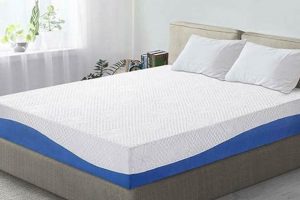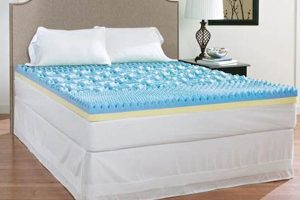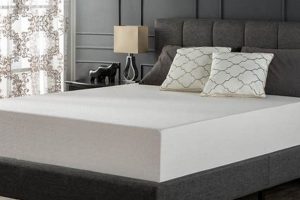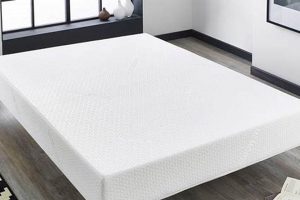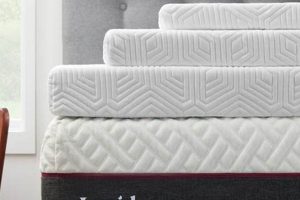The process of modifying the dimensions or shape of viscoelastic polyurethane foam, commonly known as memory foam, for bedding applications involves precise techniques to ensure a clean and accurate result. This alteration is typically undertaken to fit the foam to a specific bed frame, create custom pillow shapes, or repair damaged sections.
Altering the size of bedding foam offers several advantages, including cost savings by utilizing existing materials, customization for unique comfort preferences, and extending the lifespan of the mattress. Historically, manipulating these materials was challenging due to their density and tendency to tear, but advancements in cutting tools and methods have simplified the process.
Achieving satisfactory outcomes requires careful consideration of the necessary tools, appropriate techniques, and safety precautions. The following sections will detail specific methods and offer guidance for successful modification of these bedding components.
Tips for Modifying Bedding Foam
Achieving a clean and precise modification of bedding foam requires careful planning and execution. The following tips provide guidance for a successful outcome.
Tip 1: Accurate Measurement and Marking: Prior to any cutting, precisely measure and mark the desired dimensions on the foam. Use a long, straight edge and a marker to ensure straight, accurate lines. This step is crucial for achieving the intended shape and size.
Tip 2: Utilize an Electric Carving Knife: An electric carving knife, commonly used in food preparation, is an effective tool for slicing through bedding foam cleanly. The reciprocating blades minimize tearing and provide a smoother cut compared to other methods.
Tip 3: Employ a Long, Serrated Knife: If an electric carving knife is unavailable, a long, serrated knife can be used. Apply a slow, steady sawing motion, avoiding excessive pressure to prevent jagged edges.
Tip 4: Minimize Friction with Lubrication: Applying a small amount of lubricant, such as silicone spray or soapy water, to the blade can reduce friction and facilitate a smoother cut. Wipe the blade periodically to remove any foam buildup.
Tip 5: Cut in Thin Layers: For thicker foam, consider cutting in multiple thin layers rather than attempting to cut through the entire thickness at once. This technique improves accuracy and reduces the risk of blade binding.
Tip 6: Maintain a Steady Cutting Speed: A consistent cutting speed helps to prevent uneven edges and ensures a cleaner result. Avoid rushing the process, prioritizing accuracy over speed.
Tip 7: Work on a Stable Surface: Ensure the foam is placed on a stable and flat surface during the cutting process. This will prevent the foam from shifting and disrupting the accuracy of the cut.
These tips will assist in achieving a professional-looking modification. Proper execution will result in a customized piece that meets specific needs and extends the lifespan of the original product.
The following section will address safety considerations during the modification process.
1. Sharp cutting tools
The effectiveness of modifying a viscoelastic mattress is directly correlated with the sharpness of the cutting instrument employed. Blunt or inadequately sharpened tools will compress the foam rather than cleanly severing it, resulting in jagged, uneven edges and potential damage to the material’s cellular structure. This compression can also lead to inaccuracies in the final dimensions. For example, attempting to cut with dull scissors might result in a torn, misshapen piece unsuitable for the intended purpose.
The use of sharp cutting tools minimizes friction, allowing for a smooth and precise cut. This is particularly important when working with the dense, conforming nature of bedding foam. An electric carving knife, with its reciprocating blades, exemplifies a sharp tool designed to slice through with minimal resistance. Similarly, a long, serrated knife, when properly sharpened, can achieve comparable results through a steady sawing motion. In contrast, a dull blade necessitates excessive force, increasing the risk of accidents and further compromising the quality of the cut. Cases exist where individuals attempted to use utility knives with dull blades and created hazardous situations.
In conclusion, selecting and maintaining sharp cutting tools is paramount to successfully modifying a viscoelastic mattress. The sharpness directly influences the precision, cleanliness, and safety of the process. Failure to prioritize sharp tools can lead to unsatisfactory results, material waste, and potential injury. The correlation underscores the necessity for proper tool maintenance and selection as integral components of the modification.
2. Accurate measurements
The precision with which a viscoelastic mattress is modified is fundamentally dependent on the accuracy of the initial measurements. Inadequate attention to detail during this preparatory stage can lead to significant discrepancies between the intended result and the final product, potentially rendering the altered mattress unsuitable for its intended purpose.
- Dimensional Fidelity
The primary role of precise measurements is to ensure dimensional fidelity. This refers to the degree to which the cut piece adheres to the planned dimensions. For example, if a mattress topper is being trimmed to fit a specific bed frame, even a slight deviation in measurement can result in an ill-fitting topper. A difference of even half an inch across the width or length could prevent it from lying flat or fitting snugly within the frame. This can impact comfort and the overall aesthetic.
- Material Optimization
Accurate measurements minimize material waste. Overestimating the required dimensions can lead to unnecessary removal of material, potentially rendering it unusable for other projects. Conversely, underestimating the dimensions will necessitate additional cutting and adjustments, which can be challenging to execute cleanly and precisely. In cases of complex cuts, such as creating a custom pillow shape, accurate measurements are essential for optimizing the use of the foam and avoiding costly errors.
- Symmetry and Uniformity
For projects requiring symmetry, such as dividing a mattress into two equal sections or creating symmetrical bolsters, precise measurements are crucial for achieving a uniform and aesthetically pleasing result. Inaccurate measurements in these scenarios will lead to asymmetry, which can be visually unappealing and compromise the intended functionality of the modified mattress. Imagine bisecting the foam imperfectly, it will lead to different sizes of the outcome.
- Mitigation of Errors
strong>
The implementation of accurate measurements is a proactive approach to error mitigation. By taking careful and deliberate measurements, potential mistakes are identified and rectified before any cutting occurs. This reduces the likelihood of costly rework and minimizes the risk of damaging the foam beyond repair. For example, double-checking measurements before cutting a complex curve can prevent a significant error that would otherwise necessitate starting the project anew.
The act of precisely modifying a viscoelastic mattress requires more than just a sharp tool; it necessitates a commitment to accuracy in the initial measurement phase. The points discussed above emphasize the importance of meticulous planning and execution to ensure that the desired outcome is achieved with minimal waste and maximum precision.
3. Stable work surface
A stable work surface is an indispensable element when modifying a viscoelastic mattress. It directly influences the precision, safety, and overall quality of the alteration. Its absence can lead to inconsistent cuts, potential injury, and compromised results.
- Uniform Support
A stable work surface provides uniform support for the mattress during the cutting process. This ensures that the foam is evenly distributed and does not shift or compress unevenly. For example, cutting on a warped table or an uneven floor can cause the foam to flex, resulting in inaccurate cuts. A flat, rigid surface, such as a large piece of plywood placed on sawhorses, offers the necessary stability to maintain the integrity of the foam’s shape and density during modification. Uneven surfaces contribute to imprecise cuts.
- Enhanced Precision
A lack of stability introduces movement and vibration, making it challenging to follow pre-drawn lines accurately. A wobbly table or a surface with inadequate support can cause the cutting tool to deviate from the intended path, resulting in jagged or uneven edges. In contrast, a stable surface allows for controlled movements, enabling the cutter to maintain consistent pressure and trajectory. This is particularly crucial when executing intricate cuts or shapes, where even slight deviations can significantly impact the final result.
- Improved Safety
An unstable work environment increases the risk of accidents. If the mattress shifts or slides during the cutting process, the cutter may lose control of the tool, potentially leading to injury. A secure and stable surface provides a safe platform for maneuvering the cutting instrument, reducing the likelihood of slips, cuts, or other mishaps. The stability ensures the cutter is in control of the blade not contending with a moving piece of foam.
- Optimal Cutting Efficiency
A stable surface enhances cutting efficiency by minimizing the need for adjustments or corrections. When the mattress remains stationary and supported, the cutter can focus solely on the task at hand, without the distraction of having to stabilize the foam. This streamlined process reduces the time and effort required to complete the modification, while also minimizing the risk of errors. A firm surface allows continuous strokes.
In summary, the presence of a stable work surface is critical. It facilitates uniform support, enhances precision, improves safety, and optimizes cutting efficiency. Disregarding this element can compromise the outcome. The surface chosen must be solid, level, and spacious enough to accommodate the material being altered, otherwise the result of “how do you cut memory foam mattress” technique might differ greatly.
4. Controlled cutting speed
The rate at which a cutting tool is advanced through the material directly impacts the final result. Excessive speed can lead to jagged edges, tearing of the foam, and inaccuracies in the cut dimensions. Conversely, insufficient speed may cause the blade to bind or compress the foam, hindering clean separation. For instance, attempting to rapidly slice through dense foam with an electric knife may result in uneven edges and increased friction, potentially overheating the blade and damaging the mattress. Prioritizing a measured pace ensures a smoother, more precise outcome, essential for achieving the desired dimensions and shape.
The practical significance of maintaining a controlled cutting speed extends beyond aesthetic considerations. It also influences the structural integrity of the altered material. Rapid, uncontrolled cuts can create micro-tears or compressions within the foam’s cellular structure, potentially reducing its overall lifespan and comfort. Maintaining a slower, more deliberate pace allows the blade to cleanly separate the material without causing undue stress. A carpenter using a bandsaw to precisely cut foam for a custom cushion would exercise a controlled speed to match the density and thickness of the foam, preventing the blade from wandering or tearing the edges.
In summary, the relationship between cutting velocity and the outcome is critical. A deliberate pace minimizes the risk of damage, ensures accurate dimensions, and contributes to a longer-lasting, aesthetically pleasing result. This aspect serves as a reminder that the methodology for modifying the foam is just as important as the tool itself, contributing significantly to the overall quality of the final product. The interplay underscores the significance of careful execution in achieving a successful modification.
5. Layered cutting
Layered cutting, a methodical approach involving multiple shallow passes, presents a strategic advantage when modifying viscoelastic mattress material. This technique mitigates challenges associated with cutting through thick, dense foam in a single pass.
- Reduced Compression
Cutting through the entirety of the foam in one attempt often leads to significant compression of the material directly adjacent to the cutting edge. This compression can distort the intended shape and make it difficult to achieve a clean, accurate cut. Layered cutting minimizes this compression by removing smaller amounts of material at each pass, allowing the foam to maintain its original form and ensuring that each cut is made under optimal conditions. For instance, when creating a contoured headrest from memory foam, layered cuts help preserve the smooth curves and prevent the foam from collapsing during the shaping process.
- Enhanced Control
Layered cutting offers superior control over the cutting tool. By focusing on a small section of the foam at a time, the cutter can maintain a steady hand and precisely follow the intended cutting line. This is particularly useful when working with intricate designs or when altering the mattress to conform to a specific shape. A furniture maker, for example, might employ layered cutting when trimming foam inserts for chair cushions to ensure they fit snugly within the frame.
- Minimized Tearing
Attempting to cut through the mattress in a single pass increases the likelihood of tearing the foam, especially when using tools that are not perfectly
sharp or when encountering variations in density within the material. Layered cutting distributes the stress across multiple passes, reducing the risk of tearing and resulting in a cleaner, more professional-looking finish. Upholstery professionals utilize this method to avoid damage and reduce waste. - Facilitated Tool Handling
Forcing a cutting tool through thick foam in a single pass requires significant physical effort and can place undue stress on the tool itself. Layered cutting reduces the resistance encountered by the blade, making it easier to control and maneuver. This can be particularly important when using power tools, as it prevents overheating and extends the lifespan of the blade. This is important when using specialized knives, the operator can exert a more balanced and steady pressure.
The aforementioned facets illustrate the practicality of layered cutting in “how do you cut memory foam mattress”. By reducing compression, enhancing control, minimizing tearing, and facilitating tool handling, this approach increases accuracy and avoids damage to the foam and ensures that the final result aligns with the intended design specifications. Employing this strategy benefits a broad range of foam modifications, from simple trimming to more complex shaping applications.
6. Blade lubrication
Blade lubrication, the application of a substance to reduce friction between a cutting tool and a material, plays a crucial role in achieving clean and precise modifications to memory foam mattresses. The friction generated during cutting can lead to tearing, uneven edges, and increased effort. Lubrication mitigates these issues, ensuring a smoother and more controlled cut.
- Friction Reduction
The primary function of blade lubrication is to minimize the frictional forces between the blade and the foam. This reduction facilitates easier passage of the blade through the material, minimizing the amount of force required and reducing the risk of the blade binding or snagging. Silicone sprays or diluted soapy water are commonly used as lubricants due to their low viscosity and ability to create a thin film between the blade and the foam. When modifying a mattress, using a lubricant allows for longer, more continuous cuts without the need to stop and reposition the blade. Without lubrication, the friction will cause the blade to heat up quickly, damage the structure, and lead to potentially poor outcomes.
- Heat Dissipation
The friction generated during cutting produces heat, which can damage both the blade and the foam. Excessive heat can cause the blade to dull more quickly, while also potentially melting or distorting the foam along the cut line. Lubrication helps to dissipate this heat by carrying it away from the cutting surface, maintaining a cooler temperature and preserving the integrity of both the blade and the foam. For example, when using an electric carving knife, applying lubricant periodically can prevent overheating and prolong the lifespan of the blades.
- Cleanliness and Precision
Lubrication aids in maintaining a clean cut by preventing foam particles from adhering to the blade. These particles can accumulate and interfere with the cutting process, leading to rough edges and reduced precision. The lubricant acts as a barrier, preventing the foam from sticking to the blade and allowing for a smoother, more accurate cut. When creating custom-shaped foam inserts, blade lubrication ensures clean lines and prevents the formation of unsightly jagged edges that otherwise would be detrimental to the aesthetics and feel of the mattress.
- Enhanced Blade Life
By reducing friction and heat, lubrication contributes to extending the lifespan of the cutting tool. The reduced stress on the blade minimizes wear and tear, preserving its sharpness and effectiveness over time. Regular lubrication, especially when working with dense materials, can significantly increase the number of cuts that can be made before the blade needs to be sharpened or replaced. Cutting without lubrication can wear the blade very quickly.
The benefits illustrate the link between lubrication and the overall success in “how do you cut memory foam mattress.” By addressing factors such as friction, heat buildup, and blade cleanliness, it enables cleaner, more precise modifications. Regular application of lubricant is a critical element in ensuring a professional-looking result and extending the usability of both the mattress and the cutting tool. Skipping this step results in low quality of the work.
7. Safety precautions
Modifying a viscoelastic mattress introduces inherent risks that necessitate stringent safety measures. The use of sharp instruments, often powered, demands a proactive approach to minimize potential harm. Failure to adhere to established safety protocols can result in injuries ranging from minor cuts to severe lacerations. Eye protection, such as safety goggles, is essential to guard against flying foam particles. Respiratory protection, typically in the form of a dust mask, mitigates inhalation of particulate matter generated during cutting. Hand protection, achieved through the use of cut-resistant gloves, offers a crucial barrier against accidental blade contact. Proper ventilation is vital to prevent the accumulation of potentially harmful fumes released by the foam during modification.
Neglecting these safeguards directly elevates the likelihood of incidents. For instance, omitting eye protection can lead to corneal abrasions or embedded foam particles. Disregarding respiratory precautions can trigger respiratory irritation or exacerbate pre-existing conditions. The absence of hand protection increases the risk of cuts and punctures. Inadequate ventilation can expose the modifier to potentially toxic fumes, especially when using certain adhesives or solvents in conjunction with foam modification. Real-world scenarios highlight the consequences of neglecting safety protocols, ranging from emergency room visits for laceration repair to long-term respiratory issues stemming from inhalation of foam dust.
The intersection of “safety precautions” and the modification procedure underscores a fundamental principle: safe execution is paramount. The absence of diligent safety practices not only jeopardizes the well-being of the individual performing the modification but also undermines the overall quality and success of the endeavor. A comprehensive understanding of the risks involved, coupled with the consistent implementation of appropriate safety measures, is indispensable for responsible and effective mattress modification. Understanding the potential risks is a good step in any cutting.
Frequently Asked Questions
The following section addresses common inquiries regarding the modification of viscoelastic foam materials used in mattresses and bedding.
Question 1: What is the optimal tool for cleanly separating the bedding foam?
An electric carving knife, commonly used in food preparation, is frequently recommended. The reciprocating motion of its blades minimizes tearing and facilitates a smoother cut compared to stationary blades. A long, serrated knife is a viable alternative if an electric carving knife is unavailable, although greater care is required to maintain a straight and even cut.
Questio
n 2: Is it necessary to sharpen the blade before modifying the bedding foam?
A sharp cutting edge is crucial. A dull blade will compress the foam rather than cleanly slicing through it, resulting in uneven edges and potential damage to the material’s cellular structure. Ensure the chosen tool is properly sharpened prior to commencing the modification.
Question 3: How does one ensure accurate dimensions during the alteration?
Precise measurement and marking are essential. Use a long, straight edge and a marker to delineate the desired dimensions on the foam. Double-check all measurements before initiating any cutting to minimize the risk of errors.
Question 4: What safety measures should be implemented during the modification process?
Eye protection, such as safety goggles, is necessary to prevent foam particles from entering the eyes. A dust mask is recommended to mitigate inhalation of particulate matter. Hand protection, in the form of cut-resistant gloves, provides a barrier against accidental blade contact. Furthermore, ensure adequate ventilation to prevent the accumulation of potentially harmful fumes.
Question 5: How can friction between the blade and the bedding foam be minimized?
Applying a small amount of lubricant, such as silicone spray or diluted soapy water, to the blade can reduce friction and facilitate a smoother cut. Reapplication of lubricant may be necessary during extended cutting sessions.
Question 6: What considerations are relevant when cutting thick sections of bedding foam?
For thicker foam, consider cutting in multiple thin layers rather than attempting to cut through the entire thickness at once. This technique improves accuracy, reduces the risk of blade binding, and minimizes compression of the material.
Proper planning, careful execution, and adherence to safety protocols are essential for successful modification. Employing the correct tools and techniques will help ensure an outcome that meets desired specifications and extends the utility of the altered bedding component.
The following section will address potential complications and troubleshooting strategies.
Conclusion
The effective execution of “how do you cut memory foam mattress” operations hinges on a confluence of factors, from selecting appropriate tools and establishing a stable work environment to implementing meticulous measurement techniques and prioritizing safety protocols. The preceding exploration has detailed critical facets, including the significance of sharp cutting instruments, the necessity for accurate dimensions, and the imperative of controlled cutting speeds. Successful modification demands a comprehensive understanding of these parameters and their interdependencies.
Mastery of the techniques associated with bedding foam alteration translates to cost-effective customization, enhanced comfort, and extended product lifecycles. Proficiency enables individuals to adapt viscoelastic materials to precise requirements, optimizing both functionality and value. Continued refinement of these skills empowers users to confidently address a diverse range of modification challenges. Embracing precision, adhering to safety standards, and continuously seeking improved methodologies will ensure superior results in future foam modification endeavors.



